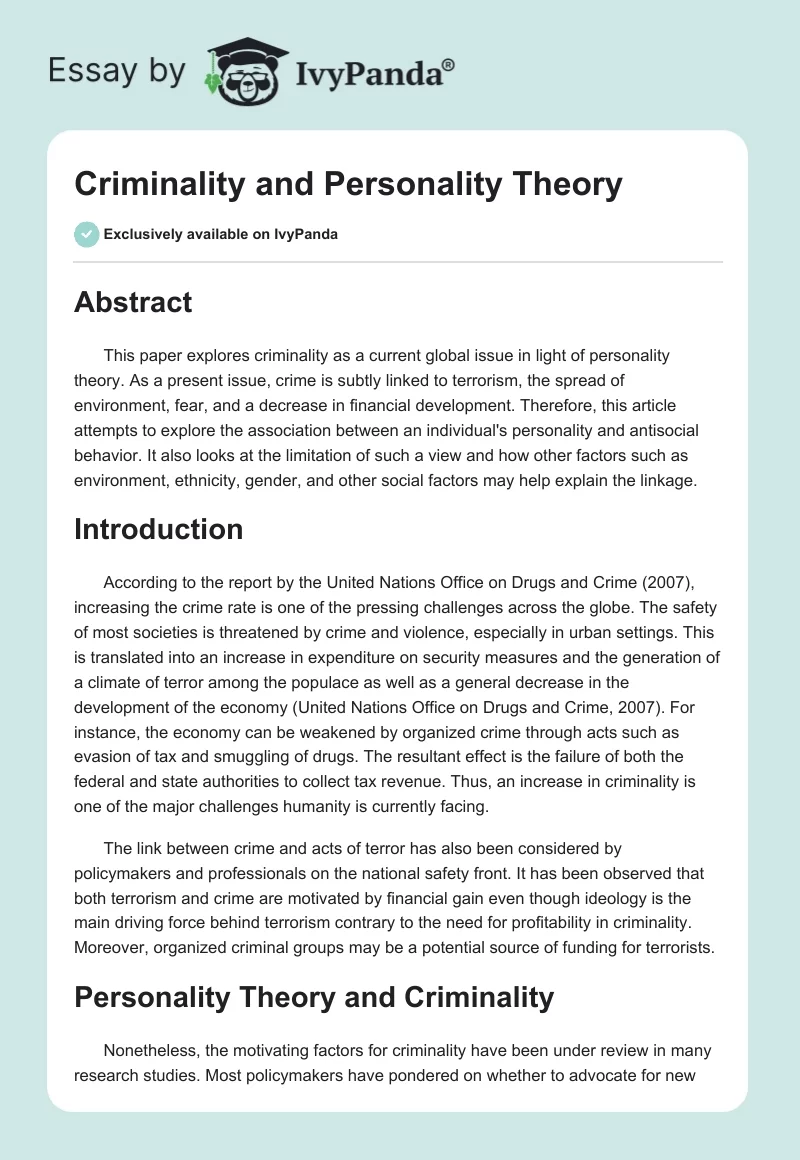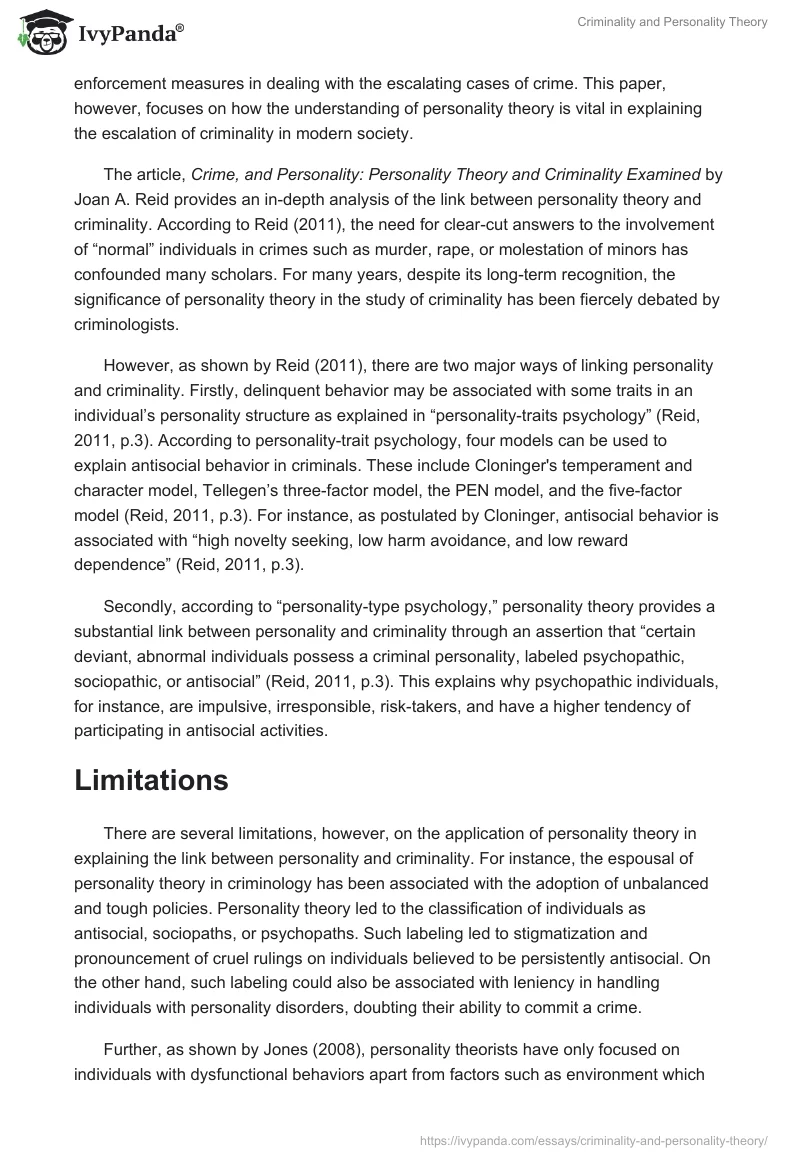Abstract
This paper explores criminality as a current global issue in light of personality theory. As a present issue, crime is subtly linked to terrorism, the spread of environment, fear, and a decrease in financial development. Therefore, this article attempts to explore the association between an individual’s personality and antisocial behavior. It also looks at the limitation of such a view and how other factors such as environment, ethnicity, gender, and other social factors may help explain the linkage.
Introduction
According to the report by the United Nations Office on Drugs and Crime (2007), increasing the crime rate is one of the pressing challenges across the globe. The safety of most societies is threatened by crime and violence, especially in urban settings. This is translated into an increase in expenditure on security measures and the generation of a climate of terror among the populace as well as a general decrease in the development of the economy (United Nations Office on Drugs and Crime, 2007). For instance, the economy can be weakened by organized crime through acts such as evasion of tax and smuggling of drugs. The resultant effect is the failure of both the federal and state authorities to collect tax revenue. Thus, an increase in criminality is one of the major challenges humanity is currently facing.
The link between crime and acts of terror has also been considered by policymakers and professionals on the national safety front. It has been observed that both terrorism and crime are motivated by financial gain even though ideology is the main driving force behind terrorism contrary to the need for profitability in criminality. Moreover, organized criminal groups may be a potential source of funding for terrorists.
Personality Theory and Criminality
Nonetheless, the motivating factors for criminality have been under review in many research studies. Most policymakers have pondered on whether to advocate for new enforcement measures in dealing with the escalating cases of crime. This paper, however, focuses on how the understanding of personality theory is vital in explaining the escalation of criminality in modern society.
The article, Crime, and Personality: Personality Theory and Criminality Examined by Joan A. Reid provides an in-depth analysis of the link between personality theory and criminality. According to Reid (2011), the need for clear-cut answers to the involvement of “normal” individuals in crimes such as murder, rape, or molestation of minors has confounded many scholars. For many years, despite its long-term recognition, the significance of personality theory in the study of criminality has been fiercely debated by criminologists.
However, as shown by Reid (2011), there are two major ways of linking personality and criminality. Firstly, delinquent behavior may be associated with some traits in an individual’s personality structure as explained in “personality-traits psychology” (Reid, 2011, p.3). According to personality-trait psychology, four models can be used to explain antisocial behavior in criminals. These include Cloninger’s temperament and character model, Tellegen’s three-factor model, the PEN model, and the five-factor model (Reid, 2011, p.3). For instance, as postulated by Cloninger, antisocial behavior is associated with “high novelty seeking, low harm avoidance, and low reward dependence” (Reid, 2011, p.3).
Secondly, according to “personality-type psychology,” personality theory provides a substantial link between personality and criminality through an assertion that “certain deviant, abnormal individuals possess a criminal personality, labeled psychopathic, sociopathic, or antisocial” (Reid, 2011, p.3). This explains why psychopathic individuals, for instance, are impulsive, irresponsible, risk-takers, and have a higher tendency of participating in antisocial activities.
Limitations
There are several limitations, however, on the application of personality theory in explaining the link between personality and criminality. For instance, the espousal of personality theory in criminology has been associated with the adoption of unbalanced and tough policies. Personality theory led to the classification of individuals as antisocial, sociopaths, or psychopaths. Such labeling led to stigmatization and pronouncement of cruel rulings on individuals believed to be persistently antisocial. On the other hand, such labeling could also be associated with leniency in handling individuals with personality disorders, doubting their ability to commit a crime.
Further, as shown by Jones (2008), personality theorists have only focused on individuals with dysfunctional behaviors apart from factors such as environment which may be responsible for the aberrations in their behavior. Therefore, personality theory still fails to point out the role of social and environmental factors in criminality. These are weaknesses in both personality-trait and personality-type psychology as fields of study.
Larger Contextual Issues
Looked into in a broader context, criminality amongst a racial minority, for instance, can be associated with increased exposure to risk factors such as family conflicts, pitiable upbringing, and environmental hazards as a result of prejudice and poverty (Moffitt, 2007). However, as noted by Reid (2011), current research on the link between personality theory and criminality is influenced by several confounding factors such as class and gender.
Conclusion
Personality theory, although under criticism, has been used to explain the link between personality and criminality. However, environmental and social factors should be taken into consideration. Without such consideration, the increase in crime will continue to be a pressing issue in modern society.
Reference List
Jones, D. W. (2008). Understanding criminal behavior: Psychological approaches to criminality. Portland: Willan Publishing.
Moffitt, T. E. (2007). Life-course-persistent vs. adolescence-limited antisocial behavior. In D. Cicchetti, & D. J. Cohen (Eds.), Developmental psychopathology (2nd ed., pp. 570-598). Hoboken, NJ: Wiley and Sons.
Reid, J. (2011). Crime and Personality: Personality Theory and Criminality Examined. Student Pulse, 3(1):2-26.
United Nations Office on Drugs and Crime. (2007). “Crime, Violence, and Development: Trends, Costs, and Policy Options in the Caribbean: A Joint Report by the United Nations Office on Drugs and Crime and the Latin America and the Caribbean Region of the World Bank.” Report No. 37820. Web.


